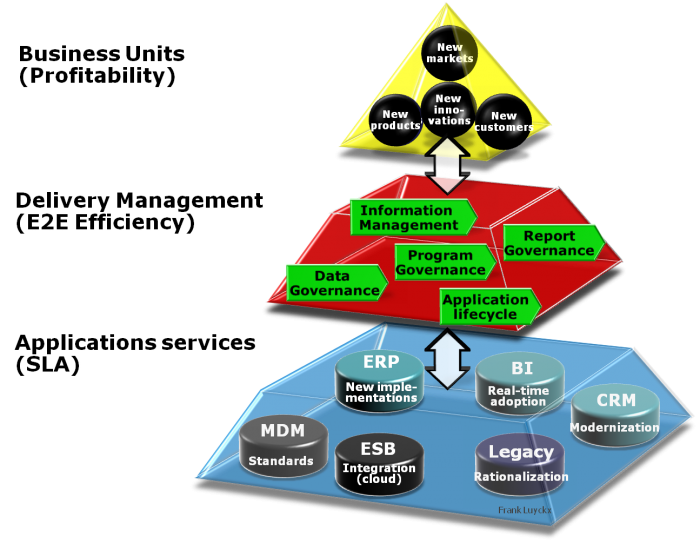The world is changing rapidly. Technology (e.g. SMAC (Social, Mobile, Analytics, Cloud)) is evolving at a speed never seen before and new ways of doing business (e.g. more license revenue) are emerging which change business models and E2E processes.
Many companies are struggling with how to integrate business model innovations within their organization and at the same time implement E2E business process improvements and execute ICT projects.
The main problem is that departments and/or projects have difficulty sharing and accepting company standards and implement their own business concepts, methods and tools. This results in the following issues;
- Limited E2E processes/technical documentation and associated knowledge of the staff
- Inefficient E2E processes leading to more disruptions and higher costs
- Inflexible and unstable ICT platform and high maintenance costs
- No overview of aging overlapping applications and tooling landscape
- Misalignment between business and IT causing the emergence of shadow applications
Even major ‘one model’ SAP template projects have configured similar E2E processes on multiple different ways which reduces operational flexibility and sharing of best practices.
The solution is to assemble an Advanced Delivery Management (ADM) team that is responsible for maintaining the quality of the company standards, E2E process efficiency and the alignment between the business units and the ERP/ICT departments.
The Advanced Delivery Management (ADM) team
A separate ADM team is required because driving E2E business innovations and E2E operational excellence to improve business profitability requires a different mindset then running and operating existing applications (keeping the light on).
The ADM team should be the glue between the business and the ICT organization using the E2E Business Process Management structure (BPM) as the foundation for the single source of truth.
The success of the ADM team will be measured by the improvement of E2E PPI’s (Process Performance Indicator) and quality management PPI’s like data accuracy.
Responsibilities of the Advanced Delivery Management (ADM) team
The ADM team should be responsible for:
1. Data Governance
The ADM team should control the data standards, data quality, data security, data integration models and the impact on the E2E processes.
2. Report Governance
The reports and the KPI hierarchy should be aligned with the E2E process structure and the business models should be aligned with the associated business KPI's and business value
3. Business Information Management
Based on Business Process Architecture the business requirements must be aligned and agreed with the business units. The business requirements must will be used to determine the required business innovations and this gives input for the project portfolio.
4. IT service management (ITSM)
Business requirements and architectural design principles must be the input for on-going application rationalization reflected in an agreed ITSM roadmap.
5. Project portfolio management
Within every organization various types of projects are launched by different teams with different objectives. The integration and long term accountability of these projects will improve quality, maintainability and TCO.
Advanced Delivery Management governance
The ADM team should be independent from the ICT and business units, in order to fulfill the quality management role. The ADM team should report to the CxO who is responsible for the optimal use of the (financial and ICT) resources of the company.
The ADM team should be managed by an ADM coordinator who is responsible for the;
- ADM (virtual) team and management of the project lifecycles
- ADM best practices and integration of the ADM standards within projects
- ADM integration platform to support the ADM business model cockpit
- ADM roadmap with the associated tracking of the benefits case
- ADM organizational readiness monitoring and potential roadblocks discovery


